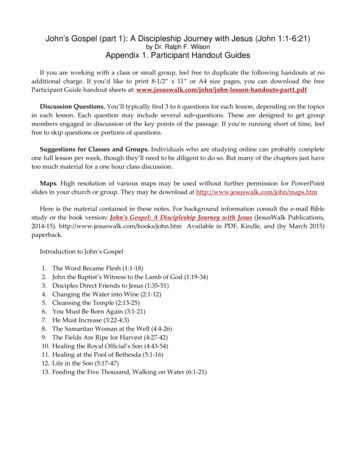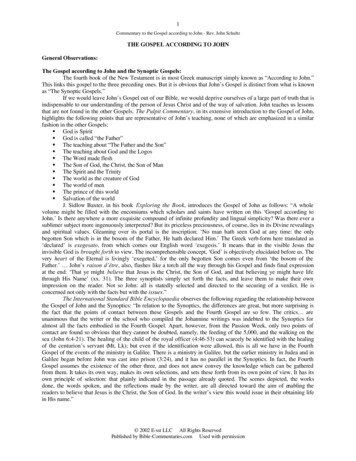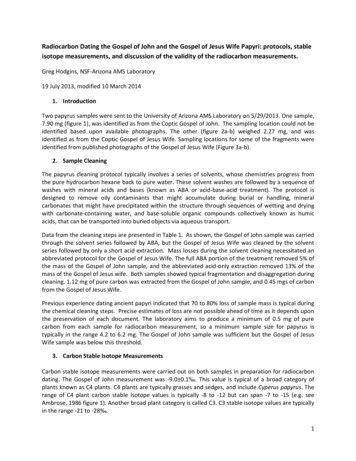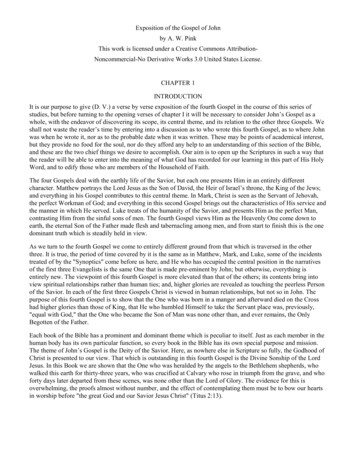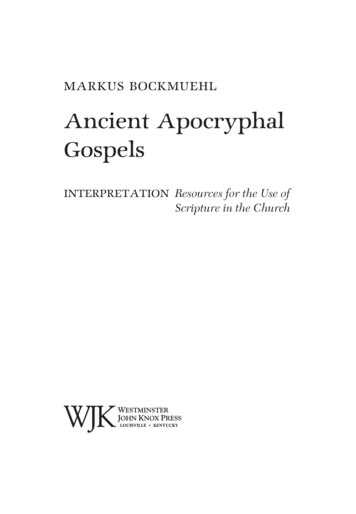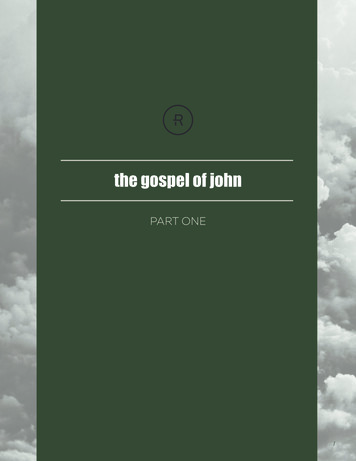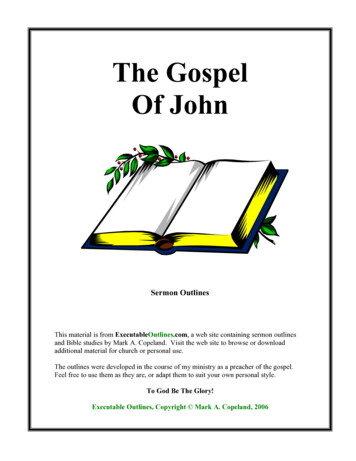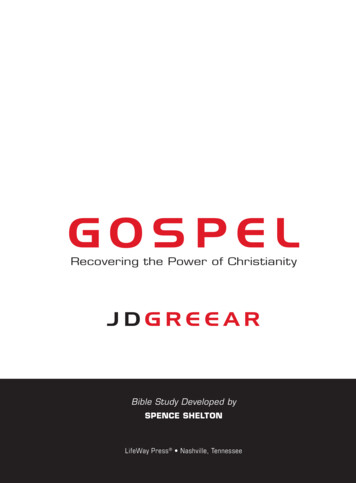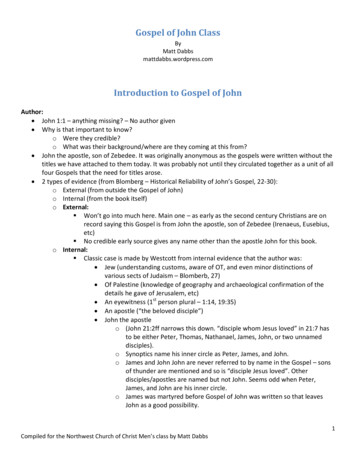
Transcription
Gospel of John ClassByMatt Dabbsmattdabbs.wordpress.comIntroduction to Gospel of JohnAuthor:John 1:1 – anything missing? – No author givenWhy is that important to know?o Were they credible?o What was their background/where are they coming at this from?John the apostle, son of Zebedee. It was originally anonymous as the gospels were written without thetitles we have attached to them today. It was probably not until they circulated together as a unit of allfour Gospels that the need for titles arose.2 types of evidence (from Blomberg – Historical Reliability of John’s Gospel, 22-30):o External (from outside the Gospel of John)o Internal (from the book itself)o External: Won’t go into much here. Main one – as early as the second century Christians are onrecord saying this Gospel is from John the apostle, son of Zebedee (Irenaeus, Eusebius,etc) No credible early source gives any name other than the apostle John for this book.o Internal: Classic case is made by Westcott from internal evidence that the author was:Jew (understanding customs, aware of OT, and even minor distinctions ofvarious sects of Judaism – Blomberb, 27)Of Palestine (knowledge of geography and archaeological confirmation of thedetails he gave of Jerusalem, etc)An eyewitness (1st person plural – 1:14, 19:35)An apostle (“the beloved disciple”)John the apostleo (John 21:2ff narrows this down. “disciple whom Jesus loved” in 21:7 hasto be either Peter, Thomas, Nathanael, James, John, or two unnameddisciples).o Synoptics name his inner circle as Peter, James, and John.o James and John John are never referred to by name in the Gospel – sonsof thunder are mentioned and so is “disciple Jesus loved”. Otherdisciples/apostles are named but not John. Seems odd when Peter,James, and John are his inner circle.o James was martyred before Gospel of John was written so that leavesJohn as a good possibility.1Compiled for the Northwest Church of Christ Men’s class by Matt Dabbs
o The point here is exactly as it should be – the author didn’t want attention or focus. Theywanted to point people to Christ.o John 21:24-25 is a little strange. Was John dictating to someone? Why the third person?Purpose:John 20:31 – “Jesus did many other miraculous signs in the presence of his disciples, which are notrecorded in this book. 31But these are written that you may[a] believe that Jesus is the Christ, the Son ofGod, and that by believing you may have life in his name.”Audience:Ephesian Christians – that is what tradition/history tells us. Church fathers tell us that John stayed inEphesus until the time of Trajan (98 AD).We are now a part of his audience! This is written more than for Ephesian Christians but for us today aswell.Date:Pre-70 AD – John 5:2 – “is” – these structures would no longer exist after the destruction of thetemple.Early Christian writers believed he wrote it in the 80s which would have put him pretty advanced inyears.Differences with the Synoptics:Matthew, Mark and Luke contain much parallel (even word for word) information.John was probably familiar with the synoptic and chooses to write something complementary to themrather than to run over all their same themes and purposes.Synoptics – more on the Kingdom of GodGospel of John – Signs that point to who Jesus is and the faith it produceso “Believe” 98 times in John; 34 times in Synopticso “Life” 66 times in John; 69 times in the whole New Testamento “Truth” 85 times in John; 78 times in the whole New TestamentWhat John Leaves Out:Parables in Synoptics 40. Parables in John 0. John does record lots of Jesus metaphors.Exorcisms – in the Synoptics Jesus is shown to be more powerful than the kingdom of this world and isbringing defeat to the powers of darkness. It may be due to the location in Ephesus (people whoheavily emphasized the demonic and magic) that he leaves these things out? You might think he wouldadd more in if that is what his audience was facing.Key stories to the synoptic: Jesus’ baptism, the temptations, Peter’s confession, the last supper andonly tells of 7 miracles.John Answers Questions Left Unaddressed in the Synoptics (from Blomberg, 53-54):John gives us more information to show why the Jewish leaders were so hostile.o Example – Jesus says, “every day I was with you, teaching in the temple courts and you didnot arrest me” (Mark 14:49). This doesn’t make sense with Jesus’ ministry in Jerusalem inMark only giving us Mon-Tues of the Passion week. John tells us of many previous times inJerusalem for various festivals that make more sense of their anger toward him inJerusalem.Why did Jesus choose to go to Jerusalem when he did?o Synoptics just say it was time.o John tells us the Lazarus situation precipitated his move toward Bethany/Jerusalem (John11) that resulted in the plot to take his life and his triumphal entryHow did Peter get into the courtyard of the High Priest?2Compiled for the Northwest Church of Christ Men’s class by Matt Dabbs
o Another disciple was with him, whom they knew that he went in with (John 18:15-16)Where did the accusations come from that he would destroy the temple (Mark 14:58-59)? Johntells us that in John 2:19Why did Jesus have to go to Pilate? (Mark 15). Only John tells us – Jewish people could not carryout the death penalty (John 18:31).Why did disciples immediately drop their nets and follow someone they didn’t know? Several ofthem already knew Jesus and had spent time with him (John 1:35ff)Structure of John:Titles for Jesus in the Gospel of John (Beasely-Murray’s Word Biblical Commentary, lxxxi):1. Word (1:1,14)2. God’s only begotten (1:18)3. Only begotten Son (3:16, 18)4. Son of God (1:34; 1;49; 11:11, 20, 31)5. The Son (3:17, 36; 5:19-27)6. Son of Man (1:51)7. Teacher from God (3:2)8. Prophet (4:19, 9:19, 6:14, 7:40)9. Messiah (1:41; 4:29; 11:11, 20; 31)10. King of Israel (1:49, 6:15, 12:13)11. King of the Jews (19:19)12. Holy One of God (6:69)13. Lamb of God (1:29, 36)14. Coming One (12:13)15. The Man (19:5)16. Sent One of God (3:16-17, 34; 5:30; 7:16-17; 10:36)17. I am (8:24, 28, 58)18. Paraclete (14:16)19. Rabbouni (20:16)20. The Lord (20:18, 21:7)21. My Lord and my God (20:28)John 1:1-18 - PrologueJohn doesn’t beat around the bush. No genealogies. No lengthy birth stories. No magi. “Jesus is God” Prettygood way to start off. D.A. Carson believes this is like a table of contents to the Gospel itself, giving hints ofwhat is to be explained further (Carson’s Pillar NT Commentary on John, 111):Pre-existence of the WordIn him was lifeHe is lightLight rejected by darknessYet not quenched by itLight coming into the worldChrist not received by his ownBeing born to GodPrologue1:1-21:41:41:51:51:91:111:13Gospel of John17:55:268:123:1912:353:19, 12:464:443:6, 8:41-423Compiled for the Northwest Church of Christ Men’s class by Matt Dabbs
Seeing his gloryOne and only SonTruth in Jesus ChristNo one has seen God except theone who comes from God’s side1:141:14, 181:1712:413:1614:61:186:46Chiasm in prologue – Parallel structure used to point to the central claim that is being made – God did all thisso that we could have faith and believe in the One He sent (Constructed out of Carson’s observations, 113).Less specificity:A) 1:1-5 – The nature of the WordB) 1:6-8 – John the BaptistC) 1:9-11 – IncarnationD) 1:12-13 (center) – Positive reception of the Word – believe in his nameC) 1:14 – IncarnationB) 1:15 – John the BaptistA) 1:16-18 – The nature of the WordMore specificity:1:1-2 – Jesus is God and is in relationship with God1:3 – Creation given/created by him1:4-5 – light given to those in darkness1:6-8 – John the Baptist’s role1:9-10 – Light was coming into the world1:11 – came into his own possession1:12a – those who received him1:12b – to those who believed on his name (see 20:31)1:12c – became children of God1:13 – we have been made God’s possession1:14 – Word was coming into the world1:15 – John the Baptist’s role1:16 – grace given to those in darkness1:17 – grace and truth given/created by him1:18 – Jesus is God and is in relationship with God4Compiled for the Northwest Church of Christ Men’s class by Matt Dabbs
Gospel of John Chapter 11:1-5 Nature of the Word1:1 – “In the beginning” – sound familiar? Beginning of the Bible, fitting beginning of the Gospel (Mark 1:1 alsostarts similarly).Just as the creation story in Genesis 1:1 was the beginning of something wholly different in theuniverse, the coming of Jesus Christ as a man into history is the start of something new and more thanrocks and trees and flesh and blood – life, and light and truth and grace.“In the beginning the Word was already in existence” (Carson). Before he put on flesh, before he diedon the cross, before David, Abraham, Moses I am (JohnLogos/Wordo Greek background - Philosophers of their day (Stoics) believed the Logos was “the rationalprinciples by which everything exists.o Jewish background - Jewish philosopher Philo believed there was an ideal world and an idealman (Logos) and then the real, existent world that we live in that doesn’t live up to the ideal.For Philo this wasn’t an actual person, but more of a concept or an ideal.o OT background – It was the Word of the Lord that created all things (Gen 1:3, Ps 33:6). God’sWord also brings deliverance and judgment (Isa 55:11, Ps 29:3ff, Psalm 107:20).o “In short, God’s Word in the OT is his powerful self-expression in creation, revelation, andsalvation and the personification of that Word makes it suitable for John to apply it as a title toGod’s ultimate self-disclosure, the person of his own Son.” – Carson, 1161:3-5 – More creation parallels: life, light, “all things were made”John is establishing the authority of Jesus Christ. There is nothing that exists that was not made byhim not even the very people who will later crucify him and not even us today.“In him was life” – implies apart from him is darkness and deathLight ? (revelation through his presence on earth (for them) resulting in the recorded Gospel (for us)),life resurrection for us, ultimately.Life light, Darkness ?What do you think the darkness represents?How is life only found in Christ?Why is life apart from Christ not life at all, rather death?1:6-8 – John the BaptistWhat was John’s role? – bear witnessWhat was his function? – to get people to believe in Jesus ChristHow did John do that, that we learn in other Gospels?He was not the light – remember how people asked him if he was the Christ? John doesn’t tell thatstory, instead he lays it all out there1:9-11 – Incarnation“the true light was coming” – shows that John came first and was preparing the way for the life-giverto come and give life.You might expect there to be lots of miracle stories, lots of healings, etc to show Jesus giving life. Thatis not how John goes about it.“the world did not recognize him”? Why? Because they were looking for the wrong kind of MessiahWhat was “that which was his own?” – the Jews, the world, mankind (since he made all things right)?5Compiled for the Northwest Church of Christ Men’s class by Matt Dabbs
How did the world respond? Rejected him. But some did accept successful mission! (1:12)1:12-13 – Reception of the WordSee John 20:31This is what it is all about – God desires us to be born of him through faith in His Son. Otherwise we arelost and dead1:14 – Incarnation“The Word became flesh and made his dwelling among us. We have seen his glory, the glory of the One andonly, who came from the Father full of grace and truth.”Word – already talked about thatBecame flesh – this is John’s birth narrative. That is not his emphasis so he doesn’t spend a ton of timeon it. He is more interested in who Jesus is than who he got here.Made his dwelling among us – literally “tabernacle among us” – tabernacle – skene, he skened amongus. Pitched his tent – temporary yet present. Recalls the wilderness experience with God’s people andthe tabernacle. Represented the very presence of God among the people. This will be an importanttheme in John – where Jesus is, God is present.Exo 33:7 – “Literally the tent of witness” – John may be alluding to this “We have seen ” (Carson, 127)“We have seen his glory” – why is that important? Eyewitness. We aren’t going to get this secondhand.Glory in Johno Jesus is here to bring glory to God (John 14:13, 17:4). Jesus expects his followers to do the same(John 15:8)o Jesus does have glory (John 8:54) and he gives us some of that glory (John 17:22).o In John 17:24 he tells God he wants his disciples to see his glory. John 1:14 tells us Godanswered that prayer.o What is “glory”? – doxa (where we get doxology)/ Hebrew Cavod (something weighty, gravitas,deserving honor). “Demands recognition (Kittel, 238).o In the other gospels and in the epistles, Jesus’ glory is reserved for after his resurrection. Not soin John.“One and only” (KJV – Only begotten) – monogenes (mono – one/only genes – something that comesfrom something else think genes as in DNA). Same word used in John 1:18, 3:16, 18, 1 Jn 4:9. Also usedin Hebrews?)o What does this word mean? NIV is a little more accurate than the KJV on this one – doesn’t justmean the only. Hebrews 11:17 – Isaac is Abraham’s “monogenes” but Abraham had otherchildren (Ishmael). It means more like special, unique, one and only.4 important days1 - Who is John the Baptist?/What is his role? (John 1:15-28)“He who comes after me surpasses me because he was before me” – an interesting statement. Jesus iseternal and even though John is older than Jesus, Jesus came before (John 1:1-2).Implied question – “Are you the Messiah?”Next question – “Are you Elijah”o John never associated himself with Elijah but Jesus did (Mtt 11:14, Mk 9:13)o Mal 4:5 – prophesied Elijah coming back before the day of the Lord (We see this fulfilled alsothrough the Transfiguration)Are you the prophet? - Jews in the first century were on the look out for the Messiah. John the Baptistwas unorthodox enough in his approach and had the full prophetic garb to attract attention. Deut6Compiled for the Northwest Church of Christ Men’s class by Matt Dabbs
18:14 prophesied a prophet like Moses who was to come and he will speak the very words of God(Deut 18:18). This is the same thing mentioned by the Samaritan woman at the well as they believedthe Prophet was the Messiah (John 4)So who are you? John knows his role in quoting Isa 40:3o He came to prepare the way for Christ.o How did he do that? He baptized He preached repentanceo The original context of the Isaiah passage was about making the return home of exiles swift andeasier John is paralleling himself with the ushering in of a new return from exile – where God’speople would return “home” spiritually speaking and be redeemed from far off.2 - John’s testimony concerning the Christ (John 1:29-34):The next day Remember, John is getting right to who Jesus is. One of the ways he does that in the beginning of hisgospel (Chapter 1) is through the use of titles that all tell us something about Jesus (Carson’s list, p.147).o Lamb of God (1:29, 36)o Elect One (1:34)o Rabbi (1:38, 49)o Messiah/Christ (1:41)o Son of God (1:49)o King of Israel (1:49)o Son of Man (1:51)o The one Moses wrote about (1:45)Notice there are parts of the story we never get that John alludes to:o Someone told him to go and baptize with watero Someone told him the one he saw the Spirit descend on was the Messiaho What kept John going? He knew that if he baptized enough people he would eventually get theright one because he was told so somehow by God through some type of messenger.o John’s testimony – “this is the Son of God”o How is this different than what we found in the first 8 chapters of Mark? – Messianic secret.o John is not building up to it he flat out tells us over and over and over who Jesus is so that wemight have faith.o “Lamb of God” – why is that ominous? So from the very beginning we get an idea of what is tocome. Lambs took away sin of the Jewish people – Jesus is the Lamb of God who takes awaythe sin of the world. Death is a part of this but it is for ALL.3 - Jesus and his first followers/disciples (John 1:35-42):The next day John testifies again, two of his followers hear him and begin to follow Jesus not in the sense of being adisciple formally but actually begin to follow him – walkingJesus first words to him – might expect “Welcome!” or something clever like “make you fishers ofmen” instead “What do you want?”o Why is that an important first question for anyone who wants to follow Jesus?o Why is that an important question for us today?o How would you answer that question – what do you hope will happen from following Jesus?o 10th hour 4 p.m.7Compiled for the Northwest Church of Christ Men’s class by Matt Dabbs
1:40-42 – The natural response to meeting Jesus – go and tell someone. This was natural because thisis probably something they talked about a lot and may have wondered if this would even happen intheir lifetimes.What would you think if the first time you met someone, the first thing they did was change yourname?Carson points out that the name change is not so much about Peter as it is about Jesus – Jesus knowspeople, everything about them even who/what they will become.4 – More Disciples (1:43-51):Philip and Nathanael1:47 – Here is a true Israelite in whom there is no deceit play on words. Israel/Jacob heel grabber one who trips you up.1:48 – “How do you know me?” Jesus’ answer – “I saw you while you were still under the fig treebefore Philip called you.”o Again Jesus knows them perfectly even though they have never met.o Also, this is better translated “Where do you know me from?” Notice, Jesus’ answer is a place.Nathanael then recognizes him as Messiah due to his knowledge of his circumstances without havingbeen there.Remember John 20:29-31 – They saw and believed. We don’t have that priviledge. It would be easierto put faith in Jesus if you met him and he told you all these things only he could know and did miraclesin your presence.He had to do these things on the front end to show glimpses of who he really was.1:51 – amen, amen very trulyo Also, another reference to Jacob/Israel (Gen 28:10-19)o Jacob called that place “Bethel” house of God. In other words, place where God dwells and ispresent.o Jesus says you will see angels ascending and descending on the Son of Man he represents thevery presence of God on earth.o Gen 28:13 – God stood above it or him – God was in Jacob’s presence and gave him a specialrevelation.o Jesus stands among them and gives them a special revelation from God himself.o Carson points out that all Jews recognized Jacob as divinely appointed for his role so too willthey have to recognize Jesus for his (164).o God is no longer revealed in the tabernacle or in the temple (his house) but in and on Jesushimself.8Compiled for the Northwest Church of Christ Men’s class by Matt Dabbs
Gospel of John Chapter 2Broader themes:1 - Signs2:11 – the first sign used to reveal his glory2:18 – “What sign can you show us to prove your authority to do all this?2:23 – “many people saw the signs he was performing and believed in his name”3:2 – “no one can perform the signs you are doing if God were not with him”4:54 – “This was the second sign Jesus performed after coming from Judea to Galilee7 signs in the Gospel of John:1.2.3.4.5.6.7.Water to wine (2:1-12)Healing of the official’s son (4:43-54)Healing a paralyzed man (5:1-15)Feeding 5000 (6:1-15)Walking on water (6:16-24)Healing a man born blind (9:1-12)Raising Lazarus from the dead (11:1-44)The 8th – resurrection of Jesus from the dead2 – Cana bookends/things made new (D.A. Carson, 166) from 2:1-4:54 both mention Cana:Water to wine – replacement of purification vesselsOld temple – new temple (risen Lord)Niccodemus – new birthJacob’s water – living waterWorship of Jerusalem and Gerizim with worship in “Spirit and in truth”First Sign – Water to WineSign of what? – That Jesus is the Son of God.o The people understood this too. In John you get lots of requests of Jesus to give people a signand that if Jesus is able to it is testimony that God is with him. John 3:2 – Nicodemus understands this John 6:30 – The people ask for a sign that they might believe him. 7:31 – the people equated the Messiah with the presence of miraculous signs John 9:16 – a sinner wouldn’t do such signs and so Jesus must not be that.Signs are there to convince people who Jesus is (faith/belief) – this happens in 2:11Symbols in play:o Beginning/end of Jesus ministry parallels: Third day – the beginning and ending of Jesus’ ministry will reference 3 days Mary – paralleled with the three days, the next time we see Mary in the Gospel of Johnis at the foot of the cross. Wine – along with 3 days and Mary, wine will also preface his time on the cross as Jesusand the disciples celebrate the Passover. “Time had not yet come” – referencing the cross (17:1).9Compiled for the Northwest Church of Christ Men’s class by Matt Dabbs
o Messianic symbols: Wedding – messianic figure in the OT (Isaiah 62:4-5)Rev 21:2 – wedding in the Kingdom of God in heaven at the end of time. Banquet – something Jesus used to symbolize the kingdom of God (Matthew 8:11, 22:114) Master of the banquet’s statement – “you have kept the choice wine until now” – “canbe understood as the proclamation of the coming of the messianic days” (R. Brown,105). The quality of what Jesus has come to do will far exceed that which preceded him.o Transformation: 6 stone jars 120 gallons overflowing abudance The messianic age was associated with “an abundance of wine” (R.Brown). – Amos 9:1314) These jars were only to be filled with “living water” water from a moving stream whichties in with John 4. Jars old order of “law and custom” (Carson) Something new is happening. Transformation – Just as the Word became flesh, he came to do transformative work onthe earth.What did this miracle accomplish?o Compassion & honor - It brought honor to the family and bride/groom. This was anembarrassing event that could have brought them shame. Jesus mends it.o It shows his power over the natural world.o Main thing - in 2:11, his disciples put their faith in him. They have more to base their followingof Jesus on.o Also he “revealed his glory” (see 1:14) – signs show us something about the glory of JesusChrist.Application:What do you need Jesus to transform and make new in your life?What areas of your life are filled with shame that Jesus can make honorable again?Cleansing the temple in Jerusalem (2:13-22):This is the first of three Passovers in Jesus ministry. Jesus’ ministry had to last at least 2 years as itbegins and ends with a Passover with one in the middle (John 6)Temple courts – this is the court of the Gentiles and not the temple building itself.Notice he treats the sellers of doves a little less harsh – doves were the sacrifice for those who couldn’tafford better. Jesus takes it a little easier on them.o Money changers used to have to sit out in the Kidron Valley near the Mt. of Olives to performthis service.Whip – no sticks or any other type of weapon was allowed in the temple courts. Jesus makes a weaponout of what is handy.2:16-17 – play on words between “Father’s house” and “house of market”Out of order with the synoptic? What is the deal?o They didn’t write these like scientific accounts of history. Often things are placed in specificspots to push forward themes or give a certain emphasis.o M,M,L put this at the end of Jesus’ ministry. John puts it at the beginning.10Compiled for the Northwest Church of Christ Men’s class by Matt Dabbs
o Why? M,M,L only have Jesus going to Jerusalem once during his ministry and that was at theend, to die and be resurrected. John puts Jesus in Jerusalem on multiple occasions. If synopticsare going to put this story in they either have to add a Jerusalem trip or put it in at a time hewas in Jerusalem. They need this story present in order to make sense of the witnesses againsthim regarding his curse of the temple (Mtt 26:61,Mk 14:58). Notice in Luke this story isfollowed by Jesus’ authority questioned and Jesus questions them about John the Baptist thissounds like earlier in his ministry rather than later.o Synoptics – it fits thematically at the end as Jesus prophetically calls out the corruption of theJewish leaders and the impending rejection of Israel if they don’t get things straightened out(Luke 19:41-44, Matt 21:18-22, 22:33-41).o Since John has him in Jerusalem on multiple occasions, it is more likely John can put this storywhere it fits chronologically.Losing our sense of wonder:Do you think anyone just thought one day, ““I have a great idea let’s fill this place up so full ofmerchants that we will forget why we came here in the first place!”How do you go from worshipping God in his house to corruption, greed, and this marketplaceactivity as if this was some common place?How are we vulnerable to that today?o Some churches have full-blown malls inside, bookstores, coffee shops, etc. This can be adistraction.Is it possible to stand in God’s presence so long that we lose our sense of wonder entirely?Can we come to trust the place more than the person? Someone tells a kid not to run in God’s houseand yet that cranky person won’t even sing the songs during worship because they aren’t theirfavorites.Jeremiah 7:1-15John 2:18 – Asked for a sign of his authority to come in there and do such a thing. Amazing becausewho gave them authority to rip people off right there by the temple?o Temple racket – coins with images of Ceasar, etc couldn’t be used in the temple and so themoney changers would exchange it out for Tyrian coins (R.Brown, 115) that could be used inthe temple. They would pocket the exchange rate difference for profit.2:19 – references the resurrection. Jesus sees in himself the replacement of the temple. He is the placeheaven and earth are connected. He represents the very presence of God among the people.o Notice he implies ”You” destroy this temple. He didn’t say he was going to. And that is exactlywhat they had been doing with all their greed. What is more, they would also destroy his bodywhich is what Jesus was talking about anyway.2:23 – Jesus did many other signs while in Jerusalem at the Passover but these are not included in thesigns John specifically points out because in 4:54 he says Jesus performed the second sign of hisministry (healing the official’s son).Jesus “is the reality to which the Temple itself points. His death and resurrection will be the reality which thewhole Passover celebration points” – Wright, 2611Compiled for the Northwest Church of Christ Men’s class by Matt Dabbs
Gospel of John Chapter 3The most referenced chapter in the BibleBroader theme – Old and New (Carson)In John 3 the Old/New Connection is Jesus’ discussion of “New birth”Bridging 2 & 32:25 literally ends with “He needed no one to testify about man, for he knew what was in man.3:1 picks up, “Now there was a Pharisee, a man named Nicodemus.”John 3:1-4Nicodemus approaches Jesus (3:1-2, 4)Bridging 3 & 4 - Sat side by side against Samaritan woman in John 4o Both have questions for himo Both recognize his authority and his status as Rabbi (3:2)/prophet (4:19)o He - Comes to him at night; She – comes in the middle of the dayo He - Comes recognizing he is from God, Rabbi, and teacher; she eventually realizes thato He doesn’t seem to want to tell anyone he is there with Jesus; She tells the whole town.What we are about to see – He should know better than this by now! She says more than she actually knowsand Jesus shows her more.John 3:5-8Jesus’ response (3:3,5-8)3:3 - “See the kingdom of God” – to experience or participate in it. This does not mean to view it fromafar, rather, to be a part of it.“Born again” – double entendreo Physical/surface meaning (Old) – physical birtho Spiritual/deeper meaning (New) – spiritual renewalo Also, this word can be translated “again” or “from above” means both.3:5 - Born of “water and the Spirit”o What does this mean?o 1 - Natural (water amniotic fluid) vs spiritual birth (baptism) Born again 2 births. One physical and one spiritualo 2 – 2 births but “water and the spirit” both refer to the second birth. Carson believes the Greek here is pointing to one birth, not two and that the one birth ischaracterized by water and Spirit.o You have to look at the OT ideas and usage of water and Spirit to understand what Jesus isgetting at here and why he should have expected Nicodemus to get it. Carson gives us much ofwhat follows (194-195):o Water in the OT: Figurative use renewal or cleansing and is often in this way combined with Spirit:Isa 44:3-4Isa 55:1-3Jer 2:13 & 17:13Ezek 47:1-12 – River from the temple12Compiled for the Northwest Church of Christ Men’s class by Matt Dabbs
See Ezek 36:24-36 – here water and Spirit combine for cleansing and to bring“transformation of the heart that will enable people to follow God wholly.” Notice, thevery next passage in Ezekiel is the valley of dry bones – Ezek 37 where God sends hisSpirit to bring renewal.o Spirit in the OT Life giving force (Gen 2:7) Eschatological references (Joel 2:28, Ezek 39:25-29) – it will be poured out and resultwill be blessings and righteousness inner renewal (Ezk 11:19-20Water & Spirit signify a new beginning, a new birth in OT and NT.o This doesn’t mean Jesus is not referencing baptism it just means their own heritage had abroader meaning with the symbols of water and spirit than JUST baptismBirth in OT – what mattered was being a child of Abraham to be “in” Jesus is saying there is more to itthan that. There needs to be an actual renewal of the self to take place that goes beyond your first,physical birth.New birth in the NT: John 1:12-13 Titus 3:5 – washing and rebirth 1 Peter 1:3 – new birth into a living hope through resurrection of J 1 Peter 1:23 – born again by imperishable seed 1 John 2:29; 3:9; 4:7; 5:1, 4, 18 What comes up the most –
o (John 21:2ff narrows this down. disciple whom Jesus loved in 21:7 has to be either Peter, Thomas, Nathanael, James, John, or two unnamed disciples). o Synoptics name his inner circle as Peter, James, and John. o James and John John are never referred to by name in the Gospel - sons of thunder are mentioned and so is disciple Jesus loved.

